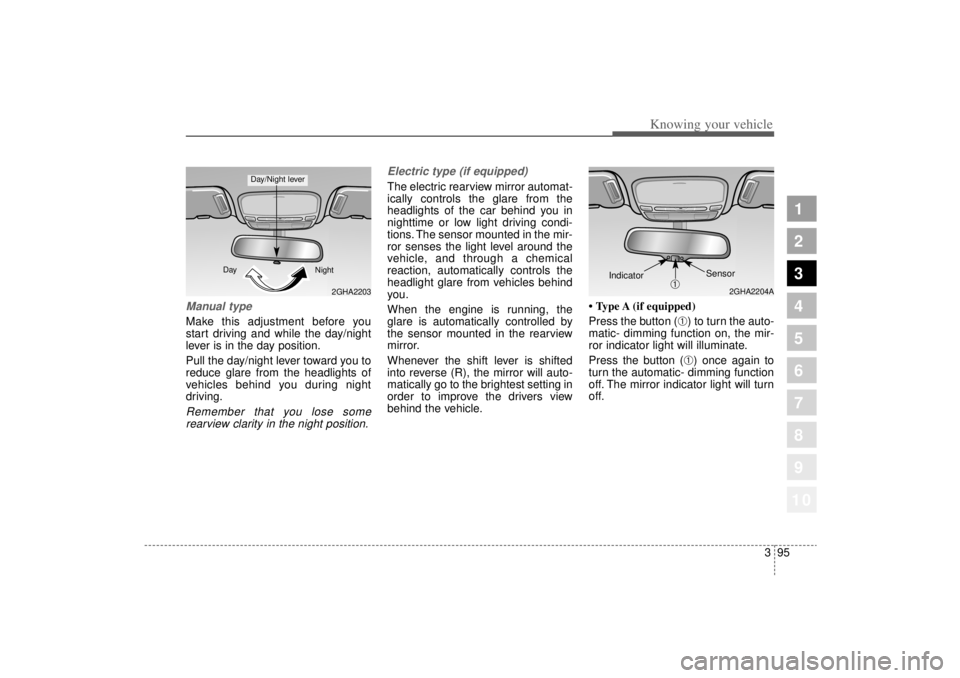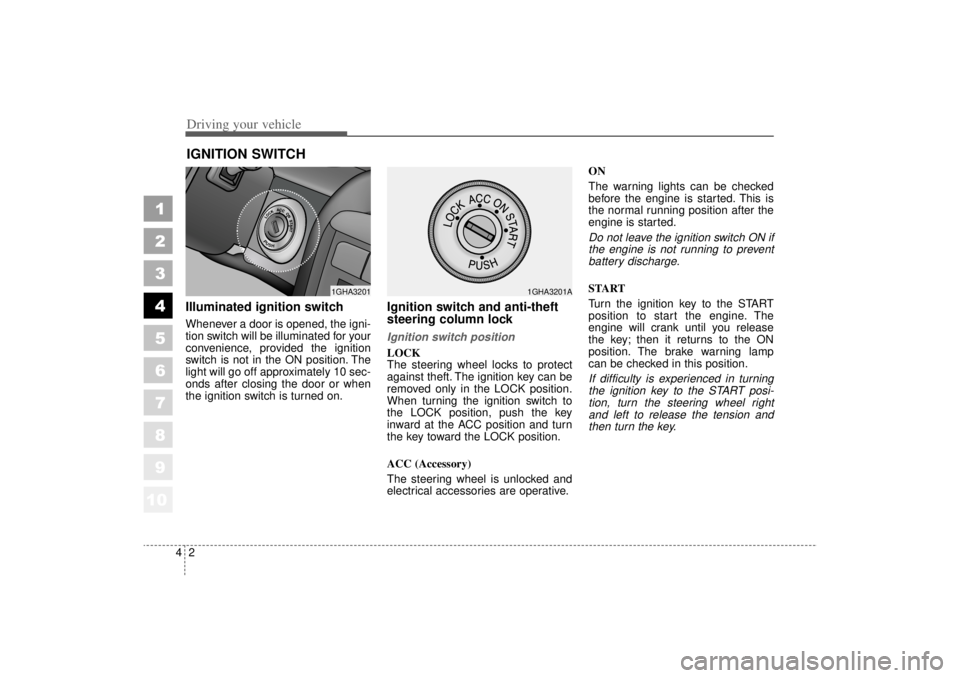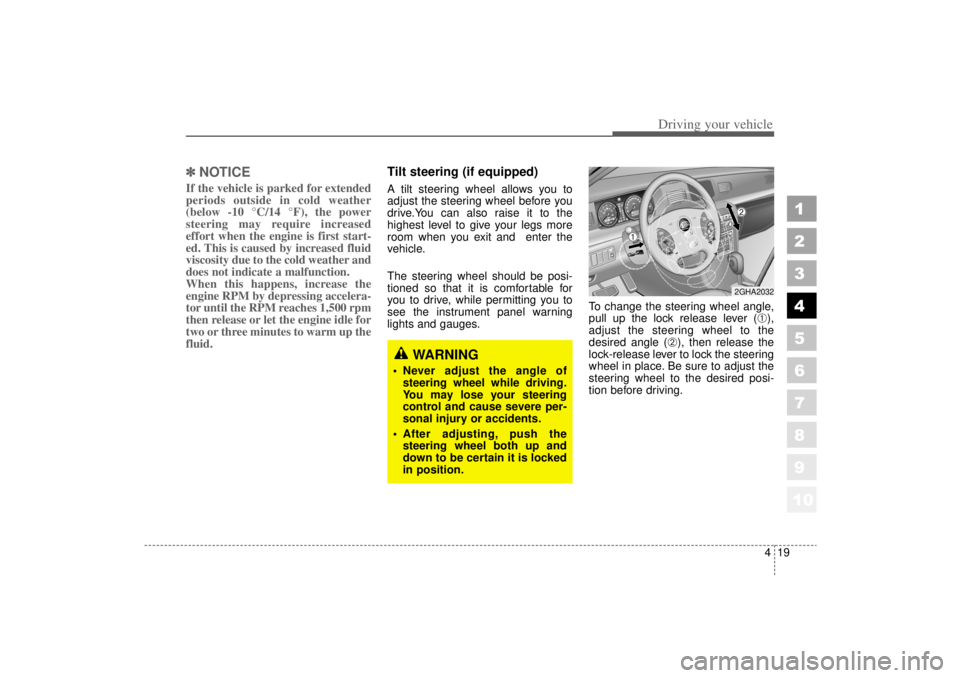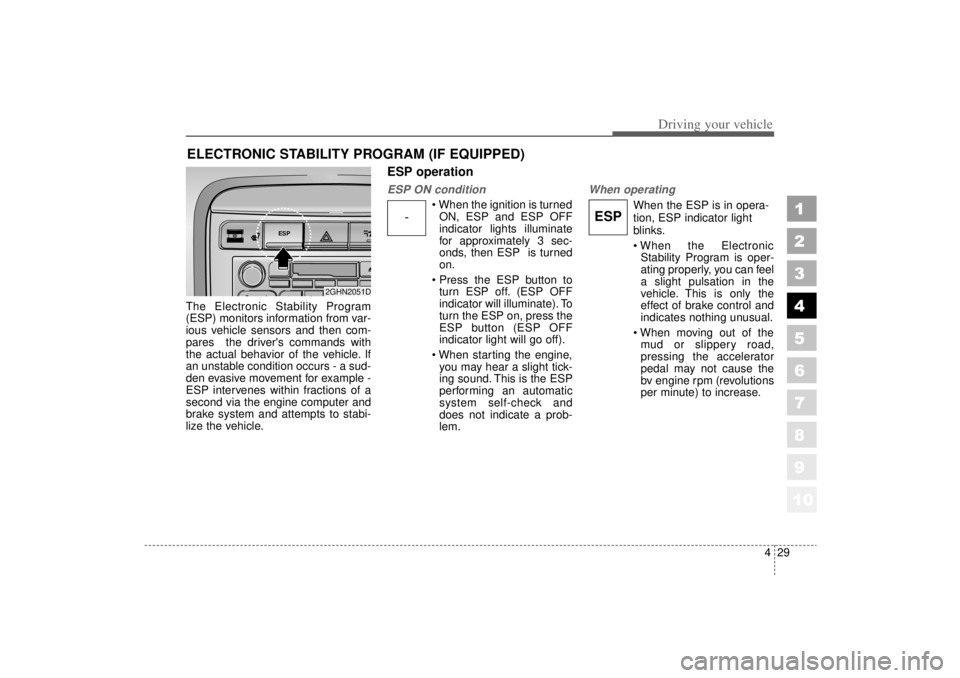Page 8 of 322
10
Your vehicle at a glance22
1
2
3
4
5
6
7
8
9
EXTERIOR OVERVIEW
1. Headlight (high beam)
2. Headlights (low beam)
3. Turn signal light
4. Side mark light
5. Engine hood
6. Inside rearview mirror
7. Seat
8. Steering wheel
9. Door
10. Outside rearview mirror
2GHN0001
Page 9 of 322
10
23
1
2
3
4
5
6
7
8
9
Your vehicle at a glance
1. Rear door child safety lock
2. Fuel filler lid
3. Rear window
4. Trunk release lever and key lock
5. Spare tire
6. Outside rearview mirror
7. Tail lights
8. High mounted stop light
9. Door handle (driver)
10. Door handle (passenger)
11. Emergency trunk release lever
2GHN0002
Page 12 of 322
101
2
3
4
5
6
7
8
9
Keys / 3-2
Remote keyless entry / 3-4
Immobilizer system / 3-7
Door locks / 3-9
Window / 3-14
Seat / 3-18
Driver position memory system / 3-34
Safety belts / 3-36
Air bags-advanced supplemental restraint system / 3-60
Trunk / 3-84
Hood / 3-88
Fuel filler lid / 3-89
Mirrors / 3-92
Interior lights / 3-97
Storage compartment / 3-99
Interior features / 3-102
Sunroof / 3-108
Antenna / 3-111
Knowing your vehicle
10
Page 106 of 322

395
1
2
3
4
5
6
7
8
910
Knowing your vehicle
Manual type Make this adjustment before you
start driving and while the day/night
lever is in the day position.
Pull the day/night lever toward you to
reduce glare from the headlights of
vehicles behind you during night
driving.Remember that you lose somerearview clarity in the night position. Electric type (if equipped)
The electric rearview mirror automat-
ically controls the glare from the
headlights of the car behind you in
nighttime or low light driving condi-
tions. The sensor mounted in the mir-
ror senses the light level around the
vehicle, and through a chemical
reaction, automatically controls the
headlight glare from vehicles behind
you.
When the engine is running, the
glare is automatically controlled by
the sensor mounted in the rearview
mirror.
Whenever the shift lever is shifted
into reverse (R), the mirror will auto-
matically go to the brightest setting in
order to improve the drivers view
behind the vehicle.
• Type A (if equipped)
Press the button (
➀) to turn the auto-
matic- dimming function on, the mir-
ror indicator light will illuminate.
Press the button (➀) once again to
turn the automatic- dimming function
off. The mirror indicator light will turn
off.
2GHA2203
Day
Night
Day/Night lever
2GHA2204A
Sensor
➀
Indicator
Page 108 of 322
397
1
2
3
4
5
6
7
8
910
Knowing your vehicle
Map light Front (if equipped)The lights are turned ON or OFF by
pressing the corresponding switch.
Dome light (if equipped)
➀
OFF - The light stays off evenwhen a door is open.
➁
DOOR - The light turns on or offwhen a door is opened
or closed.
Interior light goes out
slowly if the door is
closed.
When a door is unlocked by the transmitter, interi-
or light stays on for 30
seconds as long as the
door is not opened.
➂
ON - The light turns on and stays on even when the doors are
all closed.
INTERIOR LIGHTS
2GHA2060
OFF DOOR
ON
E2BLA324
Page 124 of 322

Driving your vehicle24
1
2
3
4
5
6
7
8
910
Illuminated ignition switchWhenever a door is opened, the igni-
tion switch will be illuminated for your
convenience, provided the ignition
switch is not in the ON position. The
light will go off approximately 10 sec-
onds after closing the door or when
the ignition switch is turned on.
Ignition switch and anti-theft
steering column lock Ignition switch positionLOCK
The steering wheel locks to protect
against theft. The ignition key can be
removed only in the LOCK position.
When turning the ignition switch to
the LOCK position, push the key
inward at the ACC position and turn
the key toward the LOCK position.
ACC (Accessory)
The steering wheel is unlocked and
electrical accessories are operative.ON
The warning lights can be checked
before the engine is started. This is
the normal running position after the
engine is started.
Do not leave the ignition switch ON if
the engine is not running to preventbattery discharge.START
Turn the ignition key to the START
position to start the engine. The
engine will crank until you release
the key; then it returns to the ON
position. The brake warning lamp
can be checked in this position.If difficulty is experienced in turningthe ignition key to the START posi-tion, turn the steering wheel rightand left to release the tension andthen turn the key.
IGNITION SWITCH
PUSH
1GHA3201
1GHA3201A
Page 141 of 322

419
1
2
3
4
5
6
7
8
910
Driving your vehicle
✽ ✽
NOTICEIf the vehicle is parked for extended
periods outside in cold weather
(below -10 °C/14 °F), the power
steering may require increased
effort when the engine is first start-
ed. This is caused by increased fluid
viscosity due to the cold weather and
does not indicate a malfunction.
When this happens, increase the
engine RPM by depressing accelera-
tor until the RPM reaches 1,500 rpm
then release or let the engine idle for
two or three minutes to warm up the
fluid.
Tilt steering (if equipped)A tilt steering wheel allows you to
adjust the steering wheel before you
drive.You can also raise it to the
highest level to give your legs more
room when you exit and enter the
vehicle.
The steering wheel should be posi-
tioned so that it is comfortable for
you to drive, while permitting you to
see the instrument panel warning
lights and gauges. To change the steering wheel angle,
pull up the lock release lever (
➀),
adjust the steering wheel to the
desired angle (
➁), then release the
lock-release lever to lock the steering
wheel in place. Be sure to adjust the
steering wheel to the desired posi-
tion before driving.
WARNING
Never adjust the angle of
steering wheel while driving.
You may lose your steering
control and cause severe per-
sonal injury or accidents.
After adjusting, push the
steering wheel both up and
down to be certain it is locked
in position.
2GHA2032
➀
➁
Page 151 of 322

429
1
2
3
4
5
6
7
8
910
Driving your vehicle
The Electronic Stability Program
(ESP) monitors information from var-
ious vehicle sensors and then com-
pares the driver's commands with
the actual behavior of the vehicle. If
an unstable condition occurs - a sud-
den evasive movement for example -
ESP intervenes within fractions of a
second via the engine computer and
brake system and attempts to stabi-
lize the vehicle.
ESP operationESP ON condition
When the ignition is turnedON, ESP and ESP OFF
indicator lights illuminate
for approximately 3 sec-
onds, then ESP is turned
on.
Press the ESP button to turn ESP off. (ESP OFF
indicator will illuminate). To
turn the ESP on, press the
ESP button (ESP OFF
indicator light will go off).
When starting the engine, you may hear a slight tick-
ing sound. This is the ESP
performing an automatic
system self-check and
does not indicate a prob-
lem.
When operating
When the ESP is in opera-
tion, ESP indicator light
blinks.
When the ElectronicStability Program is oper-
ating properly, you can feel
a slight pulsation in the
vehicle. This is only the
effect of brake control and
indicates nothing unusual.
When moving out of the mud or slippery road,
pressing the accelerator
pedal may not cause the
bv engine rpm (revolutions
per minute) to increase.
ELECTRONIC STABILITY PROGRAM (IF EQUIPPED)
-
ESP
ESP
2GHN2051D